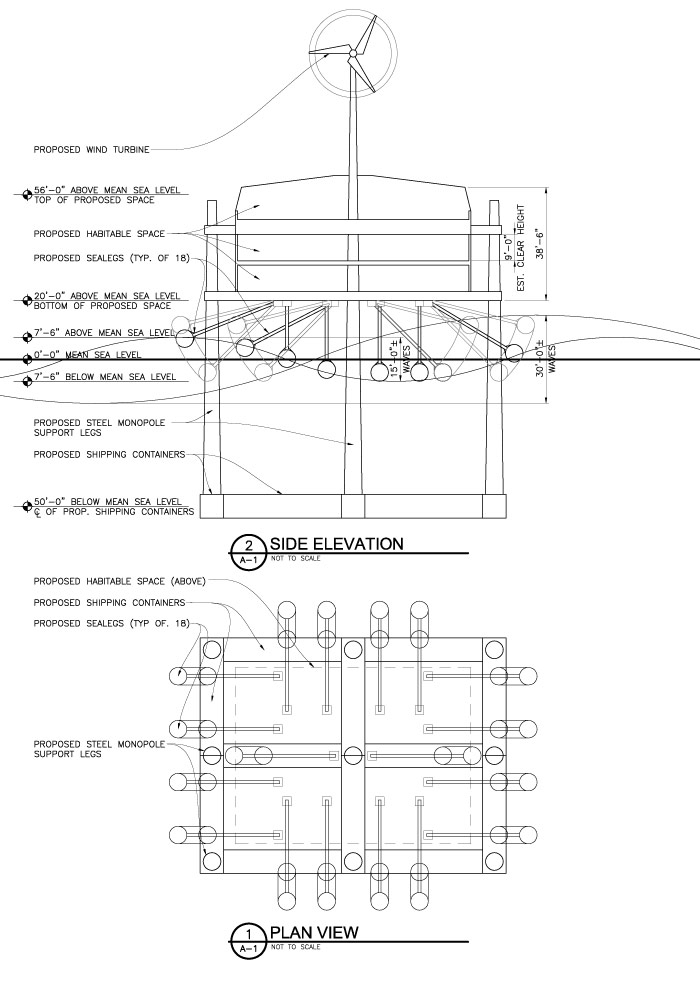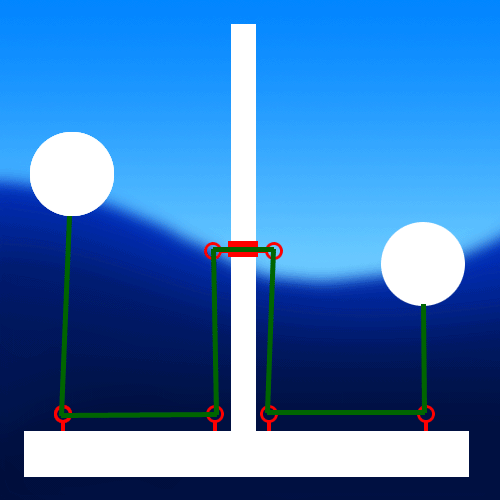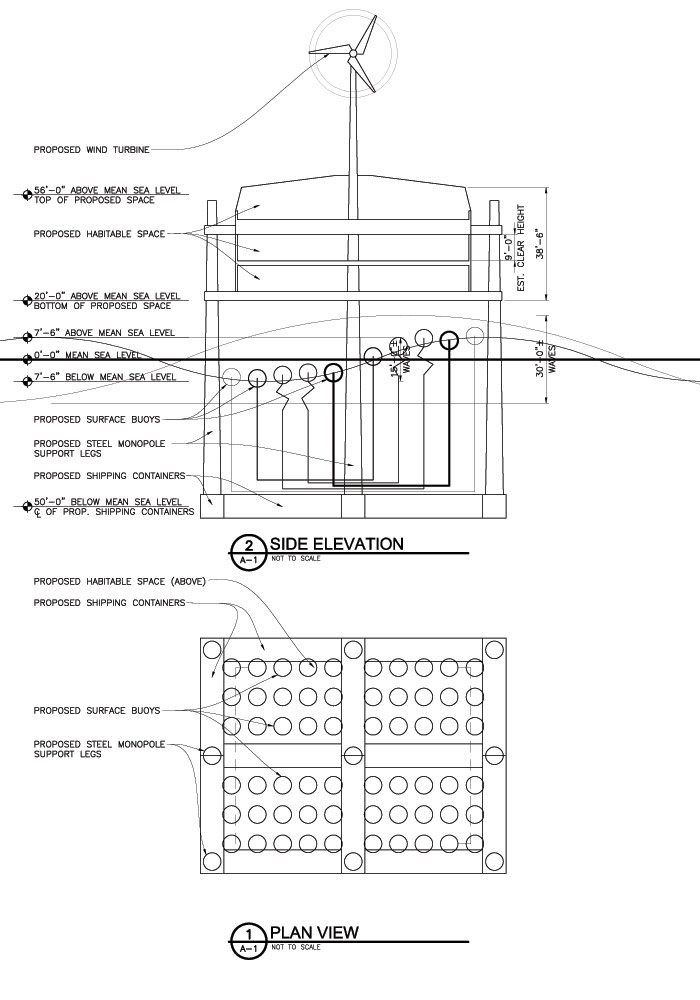Difference between revisions of "User:DM8954/Shipping Container Semi-Submersible Waterwalker Hybrid Design"
(Added new images) |
(Dual-Buoy explanation text added.) |
||
| Line 6: | Line 6: | ||
== Detail == | == Detail == | ||
Shipping Containers are mass-produced, standardized units designed to transport a variety of goods via a variety of methods (truck, railroad, and ship). The abundance of these containers and their methods of production allow them to be both inexpensive and relatively durable. These units were not designed to resist the full pressure of ocean water, especially at any significant depth. Fortunately, in this application, since they would not need to be occupied, they could be filled with air at a pressure high enough to equalize with the pressure of the water at their intended depth. In this way, the container itself would not need to resist the crushing force of the sea water. | Shipping Containers are mass-produced, standardized units designed to transport a variety of goods via a variety of methods (truck, railroad, and ship). The abundance of these containers and their methods of production allow them to be both inexpensive and relatively durable. These units were not designed to resist the full pressure of ocean water, especially at any significant depth. Fortunately, in this application, since they would not need to be occupied, they could be filled with air at a pressure high enough to equalize with the pressure of the water at their intended depth. In this way, the container itself would not need to resist the crushing force of the sea water. | ||
| + | |||
| + | Surface waves on the ocean move in such a way that their vertical motion can only be felt a certain distance below the surface. This depth is approximately equal to 1/2 the wavelength of the wave. The lower in the water an object is, the less it will bob up and down. | ||
| Line 16: | Line 18: | ||
=== Dual-Buoy Tension System === | === Dual-Buoy Tension System === | ||
| − | [[Image: | + | This is an animated illustration of how the Dual-Buoy tension system works. |
| + | |||
| + | [[Image:DualBuoyAnimation.gif]] | ||
| + | |||
| + | |||
| + | In the illustration above, there are two spherical buoys attached to each other by a single cable, which is routed through a system of pulleys. In order for the system to work, there only really need to be 2 pulleys but the extra sets will be explained later. A single buoy will float to the surface and try to stay there. By connecting two buoys together on the same cable, in this way, each will pull toward the surface either until they reach the surface or until the cable is pulled tight. Since each has the same amount of buoyancy, once the cable is under tension, the forces will be pulling equally on both ends of the line. In this way they will always find equilibrium and an equal amount of upward force will be applied to both sides of the underwater frame. These natural forces, along with freedom of movement within the cables, will allow for an overall stabilizing effect even as waves pass by unequally. | ||
| + | |||
| + | Since these buoys are on cables, rather than posts, they have a greater freedom of motion. Even if a buoy is pushed to one side by a wave, the forces can only act in tension along the cable, so that the overall force will remain nearly straight up. | ||
| + | Two buoys in this system work well but any seastead design is likely to need more buoyancy than that of only two buoys and certainly all stable designs exist in more than 2 dimensions. So, multiple pairs of buoys would be needed to create enough lift and stability. The greatest balancing effect from a pair of buoys is when they are on opposite sides of the structure and on different parts of the wave. Two buoys next to each other will be on similar parts of the wave and only lift once side of the structure, making them act much more like a single buoy normally would. Another problem to consider is the fact that wave conditions at sea often change. If the two buoys are placed at the perfect distance to counteract a 15 foot wave, a 30 foot wave, or even a 7.5 foot wave could work against the system. [In actuality wavelength and not wave height are the important factors here but wave height is typically easier to visualize] For this reason I propose spacing buoy pairs at varying distances apart so that waves of all wavelengths can more easily be balanced. | ||
| + | Waves with longer wavelengths than the length of the frame that they are attached to will move the entire structure up and down, though there should be much less of a rocking motion in the process. This can be counteracted, to a certain extent, using water entrainment by the deep buoys. However, with larger wavelengths the depth of the water affected increases so that even the deep buoys would be moved by exceedingly large waves. This can actually be somewhat of an advantage because if a wave were large enough to impact the habitable space, you would not want water entrainment effect from preventing you from rising and falling with such a large wave. | ||
| − | + | Now, you may be wondering about the extra pulleys I mentioned. The 4 pulleys in the center of the system divert the cable along a longer path. All of the dual-buoy pairs would be routed to a movable ring placed roughly at the center of the frame. By moving this ring upward while attached to the buoy pairs, the path of all the cables would be lengthened simultaneously. This would force all the buoys deeper into the water at the same time. The effect of their combined buoyancy would raise the entire structure higher in the water. By raising and lowering this ring, you can have complete control over the draft of your structure and the height of your habitable space above the water. Since the system is based on cables under tension, you could raise or lower the craft at almost any height between the bottom of the habitable space and the deep buoys. Some caution should be used, however, since raising the center of gravity too far above the center of buoyancy will make it dangerously unstable. In calm water on the open ocean, you may want to lower the entire structure to be closer to the water. If you want to enter a port, you will need to raise the entire structure out of the water far enough so that the deep buoys have enough clearance in the shallower waters near shore. This would not be recommended in choppy water but additional stabilization through the use of sealegs might be a possible safety measure for such situations. | |
| − | This is | ||
| − | [[Image: | + | === Dual-buoy Design === |
| + | [[Image:ShippingContainerHybridDesign-2.jpg]] | ||
| + | The zig-zag lines in the dual-buoys above, represent buoy pairs that are floating on the surface with enough slack in the cables so that they are not currently contributing lift. 60% of the buoys are still supporting the structure in this configuration and for these wave conditions. | ||
| − | |||
== Requirements Analysis == | == Requirements Analysis == | ||
| − | fancy math-stuff | + | fancy math-type-stuff |
| + | |||
[[Category:Proposals]][[Category:Semisubmersable]][[Category:MultiColumn]] | [[Category:Proposals]][[Category:Semisubmersable]][[Category:MultiColumn]] | ||
Revision as of 06:22, 7 March 2009
Contents
Description
The basis of this somewhat complex design is a semisubmersible that uses pressurized Shipping Containers as the primary means of buoyancy. The habitable space is suspended about 20 feet above mean sea level in order to avoid surface waves. Between the deep buoys and the habitable space are narrow supports, most likely made from coated/painted stainless steel, designed to support the structure above while minimizing the impact of waves on the structure through low surface area. This design alone doesn't have enough displacement in the water plane to maintain a stable position between the upper structure sinking to the surface and the deep buoys rising to the surface. To counteract this and to provide additional buoyancy, smaller spherical buoys, attached either to long posts or a system of cables, are added to the structure.
Detail
Shipping Containers are mass-produced, standardized units designed to transport a variety of goods via a variety of methods (truck, railroad, and ship). The abundance of these containers and their methods of production allow them to be both inexpensive and relatively durable. These units were not designed to resist the full pressure of ocean water, especially at any significant depth. Fortunately, in this application, since they would not need to be occupied, they could be filled with air at a pressure high enough to equalize with the pressure of the water at their intended depth. In this way, the container itself would not need to resist the crushing force of the sea water.
Surface waves on the ocean move in such a way that their vertical motion can only be felt a certain distance below the surface. This depth is approximately equal to 1/2 the wavelength of the wave. The lower in the water an object is, the less it will bob up and down.
Sealeg Design
Dual-Buoy Tension System
This is an animated illustration of how the Dual-Buoy tension system works.
In the illustration above, there are two spherical buoys attached to each other by a single cable, which is routed through a system of pulleys. In order for the system to work, there only really need to be 2 pulleys but the extra sets will be explained later. A single buoy will float to the surface and try to stay there. By connecting two buoys together on the same cable, in this way, each will pull toward the surface either until they reach the surface or until the cable is pulled tight. Since each has the same amount of buoyancy, once the cable is under tension, the forces will be pulling equally on both ends of the line. In this way they will always find equilibrium and an equal amount of upward force will be applied to both sides of the underwater frame. These natural forces, along with freedom of movement within the cables, will allow for an overall stabilizing effect even as waves pass by unequally.
Since these buoys are on cables, rather than posts, they have a greater freedom of motion. Even if a buoy is pushed to one side by a wave, the forces can only act in tension along the cable, so that the overall force will remain nearly straight up.
Two buoys in this system work well but any seastead design is likely to need more buoyancy than that of only two buoys and certainly all stable designs exist in more than 2 dimensions. So, multiple pairs of buoys would be needed to create enough lift and stability. The greatest balancing effect from a pair of buoys is when they are on opposite sides of the structure and on different parts of the wave. Two buoys next to each other will be on similar parts of the wave and only lift once side of the structure, making them act much more like a single buoy normally would. Another problem to consider is the fact that wave conditions at sea often change. If the two buoys are placed at the perfect distance to counteract a 15 foot wave, a 30 foot wave, or even a 7.5 foot wave could work against the system. [In actuality wavelength and not wave height are the important factors here but wave height is typically easier to visualize] For this reason I propose spacing buoy pairs at varying distances apart so that waves of all wavelengths can more easily be balanced.
Waves with longer wavelengths than the length of the frame that they are attached to will move the entire structure up and down, though there should be much less of a rocking motion in the process. This can be counteracted, to a certain extent, using water entrainment by the deep buoys. However, with larger wavelengths the depth of the water affected increases so that even the deep buoys would be moved by exceedingly large waves. This can actually be somewhat of an advantage because if a wave were large enough to impact the habitable space, you would not want water entrainment effect from preventing you from rising and falling with such a large wave.
Now, you may be wondering about the extra pulleys I mentioned. The 4 pulleys in the center of the system divert the cable along a longer path. All of the dual-buoy pairs would be routed to a movable ring placed roughly at the center of the frame. By moving this ring upward while attached to the buoy pairs, the path of all the cables would be lengthened simultaneously. This would force all the buoys deeper into the water at the same time. The effect of their combined buoyancy would raise the entire structure higher in the water. By raising and lowering this ring, you can have complete control over the draft of your structure and the height of your habitable space above the water. Since the system is based on cables under tension, you could raise or lower the craft at almost any height between the bottom of the habitable space and the deep buoys. Some caution should be used, however, since raising the center of gravity too far above the center of buoyancy will make it dangerously unstable. In calm water on the open ocean, you may want to lower the entire structure to be closer to the water. If you want to enter a port, you will need to raise the entire structure out of the water far enough so that the deep buoys have enough clearance in the shallower waters near shore. This would not be recommended in choppy water but additional stabilization through the use of sealegs might be a possible safety measure for such situations.
Dual-buoy Design
The zig-zag lines in the dual-buoys above, represent buoy pairs that are floating on the surface with enough slack in the cables so that they are not currently contributing lift. 60% of the buoys are still supporting the structure in this configuration and for these wave conditions.
Requirements Analysis
fancy math-type-stuff


